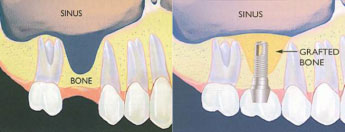A sinus lift will be required when there is insufficient bone in the pre-molar and molar region; usually the sixth tooth (first molar) in each quadrant is where the sinus is at its lowest point of the maxilla (upper jaw). It may also be referred to as ‘sinus augmentation’.
The need for a sinus lift will be due to insufficient bone due to tooth loss, periodontal disease or natural low sinus positioning. When bone loss occurs around the posterior teeth region, it can become impossible to place implants as there isn’t sufficient height or width anymore causing the maxillary sinuses (which are either side of the nose) to sit too low in the jawbone.
The maxillary sinus membrane is lifted to allow bone placement between the sinus and the jawbone. The bone used in a sinus lift may come from your own body (autogenous bone) or from a cadaver (allogeneic bone).
How is it done?
- Midazolam is administered intravenously (conscious sedation)
- You are given local anaesthetic to the sinus lift region
- You are given local anaesthetic to the donor site (where the bone will be taken from), if an onlay graft is taking place
- A small gum flap is raised to the sinus lift region/donor site (if required)
- A small, oval window is opened in the bone in the sinus region
- The membrane lining the sinus on the other side of the window separates your sinus from your jaw
- This membrane is then pushed gently up and away from the jaw
- The bone grafting material (autogenous/allogenic/synthetic) is then placed to fill the space where the sinus was
- The gum flaps are then closed and sutures are placed
Sinus Lift shown below:
Risks
Immediately after the procedure it is normal to have swelling to the region, you may also experience bleeding from the mouth and nose. It is advised not to blow your nose and try to avoid sneezing as either one could cause the grafting material to move. You will be prescribed antibiotics and painkillers by the surgeon. It may also be advised by the surgeon that you take anti-histamine tablets if you suffer from sneezing.
Once you have had the sinus lift procedure, along with the bone grafting, it is left to heal for three to nine months. The length of time it is left for varies from person to person. Here at Leeds Dental Centre, we instruct a specialist oral surgeon to carry out all sinus augmentation. We also recommend that conscious sedation is administered during this procedure.
Sinus perforation is one of the main risks during this procedure; as the sinus membrane is naturally a thin structure, it can be punctured or torn. In the event of this happening, the surgeon can stitch the membrane or place an artificial membrane over it. If the repair is not successful or the tear is too large to repair, then the surgeon may stop the procedure and allow the hole time to heal. It usually takes a few months to repair itself but once it has healed, the membrane is usually thicker and stronger, making the second attempt a more straightforward and successful procedure.
There is the chance that the graft material does not fuse with the existing bone and this means that there is no blood supply to that region,resulting in any implants that are placed in this area to fail. In the event of this happening, we can repeat the procedure.
There is also the risk of infection following the sinus lift and bone grafting procedure and although it is uncommon, there is still a small chance of it happening. If this develops, you will be advised according to your symptoms by the surgeon. The swelling and pain should start to subside after two days but you should seek help if it doesn’t. If the bleeding persists or you feel that the grafting may have dislodged due to sneezing, you should also contact the surgery.




